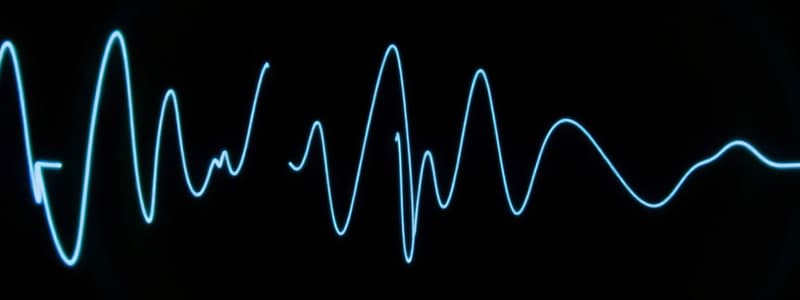Podcast
Questions and Answers
What type of waves are ultrasonic waves categorized as?
What type of waves are ultrasonic waves categorized as?
- Only body waves
- Only electromagnetic waves
- Body waves and surface waves (correct)
- Only surface waves
Which property does NOT apply to ultrasonic waves?
Which property does NOT apply to ultrasonic waves?
- They can penetrate opaque materials.
- They produce heating effects.
- They get refracted.
- They cannot be reflected. (correct)
What aspect of acoustic impedance affects ultrasonic wave interaction?
What aspect of acoustic impedance affects ultrasonic wave interaction?
- The reflected and transmitted energy at interfaces (correct)
- The temperature of the medium
- The color of the material
- The type of oscillations
How do ultrasonic waves differ from electromagnetic waves in terms of transmission?
How do ultrasonic waves differ from electromagnetic waves in terms of transmission?
What does the decibel scale measure regarding sound waves?
What does the decibel scale measure regarding sound waves?
What function does a transducer primarily serve in ultrasonic instrumentation?
What function does a transducer primarily serve in ultrasonic instrumentation?
What is true about the velocity of ultrasonic waves compared to that of light?
What is true about the velocity of ultrasonic waves compared to that of light?
Which of these statements about ultrasonic waves is correct?
Which of these statements about ultrasonic waves is correct?
What is the primary purpose of using two transducers in non-destructive evaluation?
What is the primary purpose of using two transducers in non-destructive evaluation?
What do discontinuities in the sound path indicate during testing?
What do discontinuities in the sound path indicate during testing?
What is a limitation of the through transmission technique?
What is a limitation of the through transmission technique?
In pulse-echo testing, what does the reflected energy provide information about?
In pulse-echo testing, what does the reflected energy provide information about?
What role does coupling play in non-destructive evaluation?
What role does coupling play in non-destructive evaluation?
What distinguishes immersion testing from contact testing?
What distinguishes immersion testing from contact testing?
What is the effect of applying a couplant like oil or gel in contact testing?
What is the effect of applying a couplant like oil or gel in contact testing?
What is primarily observed in the signals during immersion testing?
What is primarily observed in the signals during immersion testing?
Flashcards
Sound wave
Sound wave
A wave that travels through a medium by causing the particles of the medium to vibrate back and forth. It is a mechanical wave, meaning it requires a medium to travel.
Ultrasonic wave
Ultrasonic wave
A sound wave with a frequency higher than that of human hearing. Typically, frequencies above 20 kHz are considered ultrasonic.
Acoustic impedance
Acoustic impedance
A measure of how well a material transmits sound. It is calculated as the product of the material's density and the speed of sound in the material.
Refraction of sound waves
Refraction of sound waves
Signup and view all the flashcards
Reflection of sound waves
Reflection of sound waves
Signup and view all the flashcards
Body wave (Bulk wave)
Body wave (Bulk wave)
Signup and view all the flashcards
Surface wave
Surface wave
Signup and view all the flashcards
Plate wave
Plate wave
Signup and view all the flashcards
What is Non-Destructive Evaluation (NDE)?
What is Non-Destructive Evaluation (NDE)?
Signup and view all the flashcards
How does Through Transmission NDE work?
How does Through Transmission NDE work?
Signup and view all the flashcards
What is Pulse-Echo NDE?
What is Pulse-Echo NDE?
Signup and view all the flashcards
What is Coupling in NDE?
What is Coupling in NDE?
Signup and view all the flashcards
What is Contact Testing in NDE?
What is Contact Testing in NDE?
Signup and view all the flashcards
What is Immersion Testing in NDE?
What is Immersion Testing in NDE?
Signup and view all the flashcards
Study Notes
Ultrasonic Waves
- Ultrasonic waves are sound waves with frequencies greater than 20 kHz.
- Audible sound ranges from 20 Hz to 20 kHz.
- Frequencies below 20 Hz are called infrasound.
- Frequencies above 20 kHz are called ultrasound.
- Supersonic refers to objects traveling faster than the speed of sound in a medium.
Ultrasonic Applications
- Used in non-destructive testing of materials.
- Used to measure the elastic properties of materials.
- Used to locate ships.
- Used to measure ocean depth.
- Used in medical applications.
Properties of Ultrasonic Waves
- Transmit mechanical energy.
- Light waves transmit electromagnetic energy.
- Speed of light in air is the maximum speed for light, but not for sound.
- Ultrasonic waves can be reflected, refracted, and absorbed.
- Sound transmission is by the vibration of molecules in a medium.
- Light transmission is by the vibration of electric and magnetic fields.
- Can travel longer distances with less energy loss than electromagnetic waves.
- Can penetrate opaque materials, unlike light waves.
- Generate intense heating when passed through a substance.
Similarity Between Sound and Light Waves
- Both can be reflected and refracted.
- Both can produce interference and diffraction patterns.
Differences Between Sound and Light Waves
- Sound waves transmit mechanical energy; light waves transmit electromagnetic energy.
- Sound is transmitted by molecular vibrations; light is transmitted by electric and magnetic field vibrations.
- The speed of light in a vacuum is a maximum speed; the speed of sound varies depending on the medium.
Why Use Ultrasonic Waves?
- Travel slower than electromagnetic waves (e.g., light), enabling time-based display of information.
- Can penetrate opaque materials.
- Ultrasonic sources are generally inexpensive, sensitive, and reliable.
Modes of Propagation of Ultrasonic Waves
- In solids, sound waves can propagate in four principal modes:
- Longitudinal waves
- Shear (transverse) waves
- Surface waves
- Plate waves (in thin materials)
- Longitudinal and shear waves are commonly used in ultrasonic testing.
Types of U.S. Waves
- Body waves (bulk waves)
- Longitudinal waves: particle movement is parallel to wave propagation
- Transverse (shear) waves: particle movement is perpendicular to wave propagation
- Surface waves (e.g., Rayleigh waves)
- Travel along the boundary of a material
- Particle movement is in an elliptical path
- Plate waves (e.g., Lamb waves)
- Propagate like transverse waves in relatively thin materials
- Common in ultrasonic testing
Body Waves (Bulk Waves) Detailed
- Travel through the whole solid.
- Can be longitudinal (L-waves) or transverse (S-waves; shear waves)
- Liquids and gases have only L-waves, while solids have both L- and S-waves.
- Longitudinal waves are also called pressure or compression waves.
- The energy travels through the atomic structure in a series of compression and expansion movements.
- Transverse waves require a solid medium for propagation, causing less energy than longitudinal waves.
Surface Waves Detailed
- Propagate along the boundary of a material.
- Rayleigh waves are a common type of surface wave.
- Vibrations are limited to a shallow layer, and particles in a solid oscillate in an elliptical path.
- Used in testing, and can be used to detect surface or near-surface cracks and defects because the waves attenuate less compared to other types of waves.
Plate Waves Detailed
- Similar to surface waves, but they can only propagate in materials a few wavelengths thick (thin plates).
- Usually referred to as Lamb waves.
Lamb Waves
- Lamb waves are a type of plate wave.
- Oscillation of particles is perpendicular to the surface.
- Wave motion forms symmetrical and asymmetrical patterns.
- Used for materials with a thickness comparable to the wavelength.
Ultrasonic Wave Physics
- Particle displacement, velocity, acceleration, and pressure are all sinusoidal functions of time (represented as y = A sin(ωt + α)).
- Displacement (u) for plane waves can be written as u = A sin(ωt − kx + α).
- Dilation (S) is the derivative of displacement (du/dx).
- Pressure (P) calculation involves parameters like density (p) and velocity (V).
Acoustic Impedance
- Defined as the product of the material density and the velocity of sound within the material.
- Z = pV
- Controls the amount of reflected and transmitted energy at the boundary of two materials.
Angular Transmission and Wave Transformation
- Snell’s Law applies to both shear and longitudinal waves.
- Choosing the incidence angle controls the types of transmitted waves.
Reflection and Transmission of Ultrasonic Waves at Interfaces
- Incident waves (longitudinal or shear) result in reflected and transmitted waves.
- Four unknown wave amplitudes result.
- Snell’s Law applies.
Snell's Law Detailed
- Important relationship governing how ultrasonic waves reflect and transmit across material boundaries.
- The sine of the angle of incidence is proportional to the sine of the angle of refraction, where the ratio of the wave velocities is the constant of proportionality.
Attenuation of Sound Waves
- Intensity of a sound wave decreases with distance traveled through a medium.
- Caused by scattering (e.g., grain boundaries) and absorption (e.g., heat loss).
- Half-value thickness (HVT) is the thickness of the material required to reduce the intensity of a sound wave to half its initial value.
Decibel Scale
- A logarithmic unit used to express the ratio of two measurements.
- Used to express the change in sound intensity or amplitude between two measurements (e.g., I1, I2) with a formula involving the common logarithm and the ratio of intensities/amplitudes.
Piezoelectricity
- Several methods excite ultrasonic waves (piezoelectricity, electrostriction, magnetostriction, etc.)
- Piezoelectric effect: Applying stress to a piezoelectric crystal produces a potential difference; conversely, applying a voltage creates stress.
- Direct effect: Strain produced due to applied stress (generating ultrasound).
- Indirect effect: Applying a voltage produces strain (detecting ultrasound).
Piezoelectric Materials
- Quartz, barium titanate, lithium sulphate, Rochelle salt, lead zirconium titanate (PZT), polyvinylidene difluoride (PVDF).
Transducer Frequency/Thickness
- Crystal thickness and acoustic velocity determine the transducer's resonant frequency.
- A common design makes the thickness equal to half the wavelength (d = λ/2).
Types of Oscillations
- Damping: Friction causes energy loss during oscillations, reducing displacement over time.
- Undamped oscillations: Oscillations persist for extended time.
- Damped oscillations: Oscillations decrease over time due to energy loss.
- Heavily damped (pulse wave): Oscillations reduce to zero
- Very short waves are necessary
- useful in ultrasonics testing
- Very short waves are necessary
US Instrumentation: The Transducer
- Transducer (probe): Any device that converts energy from one form to another.
- Ultrasound transducers transmit and receive ultrasonic waves.
- Different transducer shapes and configurations depending on the application or imaging task.
Simple Single-Element Transducer Components
- Crystal: Electrically driven oscillatory piezoelectric substance.
- Electrodes: Connect the crystal to the power source for vibration.
- Matching layer: Improves ultrasound transmission efficiency.
- Backing block: Dampens the crystal's vibration, preventing reflections.
- Plastic housing: Insulates the component.
Backing Material
- Important element in transducer design.
- Dampens the oscillations, preventing unwanted reflections from interfering with measurements.
- Provides mechanical support to the piezoelectric crystal.
Sound Fields and Their Characteristics
- Cracks or defects are detected through sound waves (using transducers), creating a beam that the material reacts with (creating an echo).
- Two transducers (one to send waves, one to receive echoes) are useful to analyze areas off of direct beam path.
Near Field Length (N)
- Region near the transducer with significant sound intensity fluctuations.
- Interference patterns can cause diagnostic difficulties.
- Testing should occur in the far field; not too near the source for accuracy.
- The near field depends on the transducer's dimensions and the wavelength of the ultrasonic waves.
Non-Destructive Evaluation (NDE) of Materials
- NDE tests measure the elastic constants of materials and detect defects.
Measuring Elastic Constants
- Gases: V = √(po/ρoYo)
- Liquids: V = √(K/ρ)
- Solids: complex expressions relate velocity to elastic constants; formulas provided
Test Methods - Through-Transmission
- Two transducers, one to transmit, and other to receive.
- Loss of signal corresponds to problems.
- Used for detecting discontinuities, not good reflectors with low signal strength.
Test Techniques - Pulse-Echo
- One transducer to transmit and receive waves.
- Displays reflected waves versus time.
- Used to determine defect location, shape, and size.
Test Techniques - Contact vs Immersion
- Contact: Couplant (e.g., gel, oil) between transducer and material for efficient transmission.
- Immersion: Transducer and item are in fluid (e.g., water) for consistent coupling and movement.
Studying That Suits You
Use AI to generate personalized quizzes and flashcards to suit your learning preferences.




